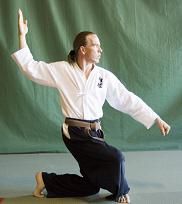TSDTexan
Master of Arts
- Joined
- Jul 18, 2015
- Messages
- 1,881
- Reaction score
- 540
Start in musubi dachi. Both feet at 45 degrees. Rotate one foot to heisoku dachi, keeping the other at 45 degrees.
Keeping a straight line, bring the heisoku dachi aligned foot straight back behind you, keeping the weight on the ball/big toe side of the foot.
The weight distribution is 50/50, the pelvis, spine and shoulders rotate to 45 degrees (in the same orientation as the lead foot), while lowering (sinking) the hip-hight through partial folding of the knee joints. (Like kosa dachi)
There is a considerable distance between the heel of the 45 degree foot and rear foot, though not as much as zenkutsu dachi.
Now... what is this called, and why can't I remember the name, or find it in my books?
Feel a senior moment coming on.
Keeping a straight line, bring the heisoku dachi aligned foot straight back behind you, keeping the weight on the ball/big toe side of the foot.
The weight distribution is 50/50, the pelvis, spine and shoulders rotate to 45 degrees (in the same orientation as the lead foot), while lowering (sinking) the hip-hight through partial folding of the knee joints. (Like kosa dachi)
There is a considerable distance between the heel of the 45 degree foot and rear foot, though not as much as zenkutsu dachi.
Now... what is this called, and why can't I remember the name, or find it in my books?
Feel a senior moment coming on.


